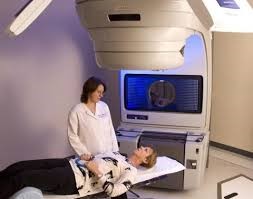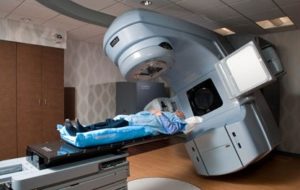What is Radiation Therapy?
Radiation therapy is a cancer treatment that uses concentrated radiation beams to kill cancer cells.
The most common type of radiation therapy is external beam radiation. This type involves a machine that directs high-energy beams of radiation at cancer cells. The machine allows radiation to be targeted at specific sites, which is why doctors use external beam radiation for nearly all types of cancer.
Radiation therapy is successfully used in the treatment of most cancers often in conjunction with surgery and/or chemotherapy. There are several steps in the radiation therapy treatment process. The first step is the consultation, which usually occurs at the request of the surgeon or medical oncologist.
Radiation therapy, or radiotherapy, is the use of various forms of radiation to safely and effectively treat cancer and other diseases. Radiation oncologists may use radiation to cure cancer, to control the growth of the cancer or to relieve symptoms, such as pain. Radiation therapy works by damaging cells. Normal cells are able to repair themselves, whereas cancer cells cannot. New techniques also allow doctors to better target the radiation to protect healthy cells.
Sometimes radiation therapy is the only treatment a patient needs. At other times, it is only one part of a patient’s treatment. For example, prostate and larynx cancer are often treated with radiotherapy alone, while a woman with breast cancer may be treated with surgery, radiation therapy and chemotherapy.
Radiation may also be used to make your primary treatment more effective. For example, you can be treated with radiation therapy before surgery to help shrink the cancer and allow less extensive surgery than would otherwise be needed; or you may be treated with radiation after surgery to destroy small amounts of cancer that may have been left behind. A radiation oncologist may choose to use radiation therapy in a number of different ways. Sometimes the goal is to cure the cancer. In this case, radiation therapy may be used to:
Destroy tumors that have not spread to other parts of your body.
Reduce the risk that cancer will return after you undergo surgery or chemotherapy by killing small amounts of cancer that might remain.
During the consultation, the radiation oncologist reviews all the medical information about your diagnosis of cancer. A physical examination then follows. Afterwards, you and your family meet with the radiation oncologist to discuss the rationale, benefits, and side effects of radiation therapy.
Why Radiation Therapy Is Done?
Radiation therapy is an important tool for treating cancer, and is often used in conjunction with other therapies, such as chemotherapy or tumor-removal surgery.
The main goals of radiation therapy are to shrink tumors and kill cancer cells. While the therapy also will likely injure healthy cells, the damage isn’t permanent. Your normal, noncancerous cells have the ability to recover from radiation therapy. To minimize the effect radiation has on the body, the radiation is targeted only to a specific point(s) in your body.
Radiation therapy can be used during different stages of cancer treatment and for different outcomes. Radiation therapy can be used:
- to alleviate symptoms in advanced, late-stage cancer
- as the primary treatment for cancer
- in conjunction with other cancer treatments
- to shrink a tumor before surgery
- to kill any remaining cancer cells after surgery
Treatment Planning
Once the simulation x-rays are obtained, the complex process of treatment planning begins. Unlike simulation, treatment planning is the behind-the-scenes work that does not require your presence. The treatment planning team consists of the radiation oncologist, medical physicist and dosimetrist. The team is specially trained to analyze various radiation therapy techniques in order to treat your cancer in the best way possible. Our centers use state-of the-art treatment planning computers to customize a unique plan for each individual patient. The medical physicist tests the plan for precision and accuracy.
Treatment
Through the efforts of the simulation and treatment planning processes, you can be confident that your treatment plan is tailored to your specific needs. There are many different ways to deliver radiation therapy, and your radiation oncologist will discuss which is best for you. Your treatment may involve external beam radiation therapy, brachytherapy or the combination of both. Often, radiation therapy is given concurrently with chemotherapy. Your radiation oncologist and nurses will review exactly what you can expect from treatment and the anticipated side effects
Treatment Process:
The steps are Setup, Planning and Delivery.
Step 1: Treatment Setup
Imaging
A special CT scan (called CT/Simulation) is acquired for every patient, and a MRI, if needed, is also acquired. Your physicians use the scans to identify the size, shape and location of the lesion/tumor along with the surrounding vital structures to be avoided.
Making a Mask or Body Mold
Depending on the need for treatment, a custom soft mask (for head/neck treatments) or body mold is formed and used to help minimize movement during the treatment and ensure your comfort. The process is simple and painless.
Fiducial Placement
The treatment of body (non-head) lesion/tumor using the CyberKnife System requires the implantation of gold seeds referred to as fiducial markers. These fiducial markers require a short outpatient procedure to implant 3-6 seeds in and/or around the tumor. This will enable Cyber Knife System to track the tumor throughout the treatment. Lesions in the head and spine do not need this placement.
Step 2: Treatment Planning
You’re previously obtained CT and MRI data are sent to the Cyber Knife treatment-planning computer where the physicians’ team will use advanced software to customize the radiation beams that the robot will deliver to the tumor or lesion during your treatment. You do not need to be present during this step.
Step 3: Treatment Delivery
Arriving
Wear comfortable clothing and no jewellery. You may bring your favourite music CD to listen to during the treatment. Try to relax knowing this will be a painless procedure. Feel free to bring a list of questions to ask the Cyber Knife team. We are here to ensure your comfort and safety.
Positioning
You will be asked to lie on the treatment table and will be fitted with the custom mask or body mold made for you earlier during the set-up process. In some cases a mild sedative will be given to you to help you relax, along with any other medication that may be needed during treatment. In some cases anaesthesia may be required; this evaluation will be done prior to treatment.
Painless Treatment
During treatment, you will need to lie still. You may sleep during the procedure. The length of treatment varies depending on the location of your lesion/tumor. The image guidance system periodically compares x-ray images to the CT scan to ensure the radiation is targeted accurately at the tumor.
Completion
When your treatment session is completed, our nursing staff will do an assessment. When the nursing assessment has been completed, you will be released to home and may resume normal activity within 24 hours. Your physician will prescribe between 1 to 5 treatments. To maximize your healing, we might insert rest days between the treatment days, depending on the treatment site.
How to Prepare for Radiation Therapy
The first step in radiation treatment is determining that it is the right form of treatment for you. Your doctor will also determine dosage amounts and the frequency of radiation best suited for your cancer type and stage. Sometimes your doctor may decide that radiation therapy is best suited for use at a later stage, so you may receive other cancer treatments first.
Preparation for radiation therapy involves a radiation simulation, which typically includes the following steps:
- You will lie on the same type of table that will be used for your treatment.
- Lying still at the proper angle is very important for treatment success, so your healthcare team may use cushions and restraints to position you at the best angle for treatment.
- You will then undergo computed tomography (CT) scans and/or X-rays to determine the full extent of your cancer and where the radiation should be focused.
- After determining the best location for radiation treatment, your treatment team will then make the area with a very small tattoo (usually the size of a freckle). In certain cases, a permanent tattoo is not needed.
- You are now ready to begin radiation therapy.
Following Up After Radiation Therapy
During the weeks of treatment, your healthcare provider will closely monitor your treatment schedule, dosing, and your general health.
You will undergo several imaging scans and tests during radiation so your doctors can observe how well you are responding to treatment. These scans and tests can also tell them if any changes need to be made to your treatment.
If you experience side effects from radiation—even if they are expected—tell your healthcare provider at your next appointment. Sometimes, even small changes can make a big difference in lessening side effects. At the very least, you may be given advice or a medication to help ease the discomfort.
As with any radio surgery or radiation therapy procedure, your progress is likely to be monitored by follow up exams and imaging.
